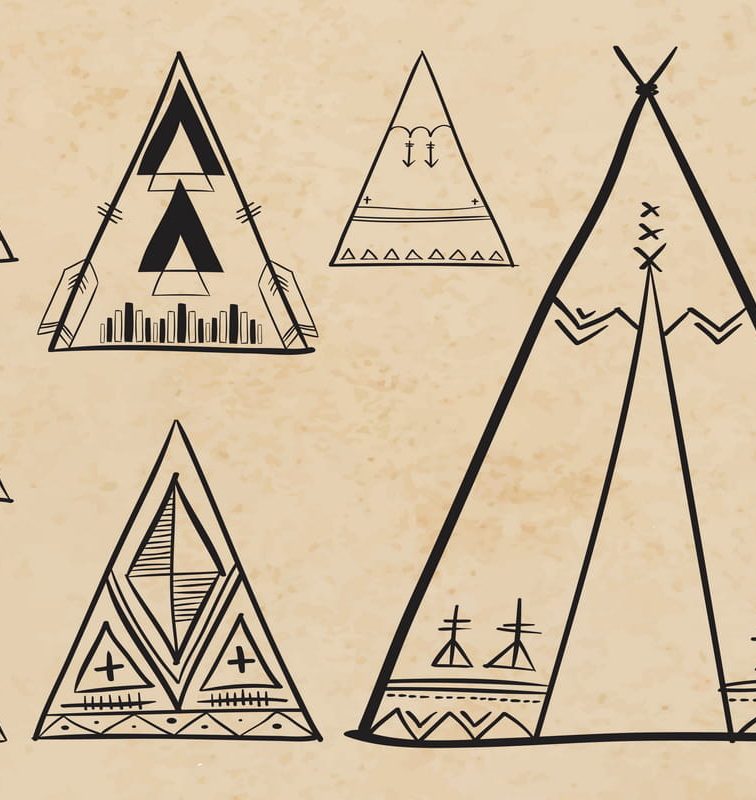Triangles, these three-sided figures, have been fascinating mathematicians for millennia, and among them, the scalene triangle stands out as a unique specimen. With all its sides and angles differing, it’s like the wild card of the triangle family.
But did you know that the word ‘scalene’ comes from the Ancient Greek word ‘skalenos‘ meaning ‘uneven’ or ‘crooked’? Or that scalene triangles have been used in architectural designs for centuries due to their versatility? Dive into these fun facts about scalene triangles and uncover the intriguing world of this distinctive geometric shape.
1. What’s in a Name? The Origin of “Scalene”
The term “scalene” might pique the curiosity of language lovers. Its roots trace back to Ancient Greece, derived from “skalenos,” which means “uneven” or “irregular.” A fitting description for a triangle that refuses to conform.
By the time Euclid released his works around 300 BC, the foundational principles of triangles, including the scalene, were being laid down. This historical association showcases how scalene triangles have been intriguing mathematicians for over two millennia.
2. Never Playing Favorites: All Sides Different
In the vast world of triangles, the scalene stands distinct, refusing to mirror any of its sides. This non-conformity isn’t just about being different; it’s rooted in the triangle’s core properties that set it apart from its counterparts.
This attribute caught the attention of renowned 19th-century mathematicians, like Karl Friedrich Gauss. His exploration into non-Euclidean geometry emphasized the uniqueness and significance of scalene triangles, proving that sometimes, being different can lead to groundbreaking discoveries.
3. Angles Have Their Own Story: None Are Equal!
Scalene triangles don’t just differ in side lengths; their angles are a whole other story. Each corner of this triangle tells a tale, with every angle being distinct and never mirroring its counterparts. It’s like a triad of uniqueness, each angle bringing its flavor to the mix.
This angle diversity was spotlighted by Leonhard Euler in the 18th century. His meticulous exploration into triangle properties highlighted the varying angles of scalenes, further proving that in geometry, every degree and dimension holds a tale waiting to be told.
4. Where’s the Right Angle? Can a Scalene Have One?
Imagine a scalene triangle chilling in a geometry party. It approaches a right triangle and says, “Hey, I can have a right angle too!” And that’s not just triangle humor. A scalene triangle can indeed possess a right angle, making it a scalene right triangle. The other two angles, of course, are acute, staying true to its scalene roots.
Historical data shows Pythagoras, around 570–495 BC, laying foundations about right triangles. So, while the Pythagorean theorem is often associated with the classic right triangle, our versatile scalene can fit right in, demonstrating the theorem’s broad applications.
5. Comparing the Clan: Scalene vs. Equilateral & Isosceles
In the triangle family, scalenes are like the independent, quirky siblings. Unlike equilaterals, with their perfect symmetry, or isosceles triangles flaunting two equal sides, scalenes celebrate their individuality with three unequal sides and angles.
Research indicates that by the 16th century, the classifications of triangles were well-established in textbooks. Early geometrists distinguished between them based on side lengths and angles. So, while equilaterals and isosceles have their charm, scalenes revel in their unique geometry, showcasing diversity within triangular kin.

Image: mdpi.com
6. Historic Triangles: Scalene’s Place in Ancient Math
Scalene triangles weren’t just geometric figures. In ancient civilizations, they held symbolic and practical significance. Babylonians, for instance, used scalene triangles in architectural designs and calculations, integrating them into their ziggurats and temples.
Fast forward to Ancient Greece, the scalene became a topic of discourse among mathematicians. Renowned scholars like Thales and Euclid used scalene triangles as examples to prove broader geometric theories, solidifying the scalene’s place in the annals of mathematical history.
7. Making the Cut: The Altitude & Scalene Triangles
Every triangle boasts an altitude – that perpendicular line dropped from a vertex to its opposite side. In scalene triangles, these altitudes are especially intriguing. Given the triangle’s unique side lengths, each altitude differs, offering a geometrically rich playground for math enthusiasts.
Historically, altitudes have been pivotal in various mathematical proofs. By the time of Bhaskaracharya in 12th century India, detailed explorations into triangle properties often spotlighted altitudes. For scalenes, these lines of reference further emphasize the triangle’s diverse and complex nature.
8. Interior Angles Magic: Always Adding Up to 180°
One of the coolest quirks about triangles? No matter how wild and uneven their sides and angles, if you sum up the interior angles, you always get a neat 180°. Scalene triangles, with their distinct angles, are no exception to this rule.
Historically, this fact has been a pillar of Euclidean geometry. By 300 BC, Euclid’s works emphasized that every triangle’s angles, regardless of type, summed up to two right angles. It’s kind of like the secret handshake of the triangle club!
9. It’s All Relative: The Longest Side vs. Largest Angle
Here’s an intriguing fun fact about scalene triangles: the longest side is always opposite the largest angle, and vice versa. It’s like a dance between length and degrees, always in harmony, always in sync.
This relationship has been a topic of geometric studies for ages. Ancient scholars, like Alhazen in the 10th century, explored such relationships in depth, making significant contributions to triangle theory. Scalene triangles, with their varied sides and angles, beautifully demonstrate this geometric dance.
10. Art & Architecture: Scalene Triangles in Design
The charm of scalene triangles isn’t limited to just textbooks. Throughout history, these triangles have graced art and architecture, bringing asymmetry and dynamic flair. Whether in the intricate mosaics of Byzantine churches or the avant-garde designs of modern architects, scalene triangles make a statement.
Le Corbusier, a 20th-century architect, often integrated geometric forms, including scalene triangles, into his revolutionary designs. The interplay of different lengths and angles offered an aesthetic appeal that resonated across eras.

Image: pinterest.com
11. Science Loves Scalene: Natural Examples in the World
Turns out, Mother Nature is quite the geometry enthusiast. Scalene triangles, with their asymmetry, can be spotted in various natural formations. From the markings on certain animal skins to the layout of certain crystals, nature embraces the scalene.
Researchers, studying patterns in nature, have identified the prevalence of these triangles in various ecosystems. For instance, the patterns on a giraffe’s skin or the arrangement of certain plant leaves often mirror scalene triangles. It’s a beautiful reminder that math isn’t just numbers on paper; it’s woven into the fabric of our world.
12. Area Calculation: Heron’s Formula & Scalene Triangles
If ever there was a hero for scalene triangles, it’d be Heron of Alexandria. This ancient mathematician whipped up a nifty formula for calculating the area of a triangle based on its side lengths, perfect for our asymmetrical friend, the scalene.
Historically, Heron’s formula (circa 60 AD) was groundbreaking, allowing for direct area calculation without needing an angle or height. For a scalene, this means no more awkward altitude measurements; just plug in those three unique side lengths and voila!
13. Pythagorean Theorem: Does It Work with Scalenes?
Remember our scalene-right triangle from earlier? Here’s where it shines again. The Pythagorean theorem, famous for its a^2 + b^2 = c^2 equation, isn’t exclusive to typical right triangles. If our scalene triangle has a right angle, this theorem fits like a glove!
Historical records show that the theorem predates Pythagoras, with evidence from ancient Babylonian tablets. Scalene right triangles offer a refreshing perspective on this age-old concept, showing math’s versatility.
14. Learning Curve: Why Scalenes Are Taught in Schools
Ever wonder why your math teacher was so enthusiastic about scalene triangles? These triangles, with their three distinct sides and angles, offer a robust introduction to geometry. They challenge students to grasp the definition of triangles, explore properties, and understand diverse geometric relationships.
Historical pedagogy trends indicate that scalene triangles have always been fundamental in geometry curricula. Their complexity makes them ideal for nurturing analytical skills, fostering a deeper appreciation for the world of math.
15. The Odd Triangle Out: Fun Pop Culture References
Turns out, scalene triangles aren’t just for math nerds. Pop culture, in its quirky ways, has embraced these asymmetrical shapes. From designs on album covers to plot points in cult classic films, the scalene triangle has made unexpected cameos.
A fun fact? The band “Scalene” took inspiration from the triangle, reflecting their unique blend of musical styles. It’s fascinating how a geometric figure can influence art and popular narratives, showcasing the unexpected intersections of math and media.

Image: ivorycircle.bandcamp.com
FAQ
What makes a scalene triangle special?
Scalene triangles are like the rebels of the triangle family. While most triangles might have at least two sides or angles that are the same, scalene triangles march to the beat of their own drum. Every side and every angle in a scalene triangle is different. It’s this complete lack of symmetry that makes them stand out. In the vast universe of triangles, from equilateral to isosceles, the scalene stands proud with its distinct, unmatched sides and angles.
What statement is true about a scalene triangle?
One undeniable truth about a scalene triangle is that all of its sides have different lengths, and all of its angles have different measures. Unlike an isosceles triangle which has two sides of equal length or an equilateral triangle where all sides are equal, a scalene triangle doesn’t play favorites. Every side and angle is unique, making it the ultimate example of diversity in the triangle world.
What are the things that are scalene triangles?
In the world around us, scalene triangles are more common than one might think. These asymmetrical triangles can be spotted in various designs, from architectural elements in buildings to patterns in fabrics. Nature too has its share of scalene-inspired designs; think of certain leaf shapes or patterns on animal skins. In art, scalene triangles provide an asymmetrical balance, which can be visually intriguing. Even in certain technical fields like engineering or graphic design, the distinct properties of scalene triangles come in handy.
Who invented scalene triangle?
The concept of the scalene triangle wasn’t so much “invented” as it was “recognized and studied.” Triangles have been known to humanity since ancient times, with early civilizations like the Babylonians and Egyptians using them in various constructions and mathematical studies. Ancient Greek scholars, including the likes of Pythagoras and Euclid, further delved into the properties and classifications of triangles. While it’s hard to pin down a single individual who “discovered” the scalene triangle, it’s clear that its properties have been explored for millennia.
Is a scalene triangle a unique triangle?
In terms of its properties, the scalene triangle is indeed unique. While other triangles might share some similarities (like having equal sides or equal angles), scalene triangles are defined by their differences. No two sides or angles in a scalene triangle are the same. However, while the category of scalene triangles is unique, there are countless possible scalene triangles, each differing by the lengths of their sides and measures of their angles.
Is a scalene triangle always congruent to itself?
Yes, any shape or figure, including a scalene triangle, is always congruent to itself. This is based on the reflexive property of congruence in geometry. Just like you are identical to yourself, a scalene triangle is always congruent to its own shape and size.
Is it true that all scalene triangles are similar?
No, it’s not true that all scalene triangles are similar. For triangles to be similar, their corresponding angles must be congruent (or equal in measure), and this is not the case for all scalene triangles. Two scalene triangles can have completely different sets of angle measures, meaning they wouldn’t be similar to each other. While some scalene triangles might be similar due to having the same angle measures, it’s not a blanket rule for all.








